-
Posts
1,147 -
Joined
-
Last visited
-
Days Won
12
Content Type
Profiles
Forums
Blogs
Gallery
Events
Store
Posts posted by Elmar Lang
-
-
Hello,
this badge exists also in the "Kriegsmetall" zinc alloy. I've never seen it with a fastening pin, but always with two holes to sew it to the cap (although havier than most other "Kappenabzeichen").
Enzo
0 -
Hi,
the cross on Marshal Rokossovski's breast is the 1st Class of the "Order of the Cross of Grunwald", instituted by the Polish authority under Soviet control in November 1943; decrees from February 20th 1944 and December 22nd of the same year.
The proposal to institute this order came from the chief of General Staff of the People's Guard, Franciszek Jozwiak (May 1943); the order was designed by Stanislaw Nowicki, editor of the People's Guard's clandestine newspaper "Gwardiszta".
The order, in its symbolic significance, had to remember the struggle of the Polish people against the Teutons, ended with the victory of Gr?nwald in 1410. The decree of institution of this order began with these words: "The Cross of Grunwald is a Polish decoration awarded for acts of gallantry in the armed struggle for the Liberty and Independence of Poland against the occupying forces...".
The order was divided in three classes:
1st Class: a large gold (or -later- gilt) cross, the centre with a shield charged with two "antique" swords; on the reverse, a shield inscribed "1410 KG 1944";
2nd Class: the same, but smaller; in silver, with gilt borders;
3rd Class: as the 2nd Class, but all in silver.
From its institution and until 1983, this order was awarded 5738 times: 71 1st; 346 2nd and 5321 3rd Classes.
The decorations were made in the Soviet Union, then at the Polish State Mint. Soviet-made pieces are very rare...
As we can see, cross-shaped orders were still adopted or maintained from the Polish communist authorities (Virtuti Militari, Polonia Restituta, Cross of Grunwald, etc.), despite the other countries under Soviet influence.
Best wishes,
Enzo
0 -
Hello,
to add some little data to this thread, my Red Banner orders "2" with ribbon, bear the numbers 5376 and 10676. The first of them is also struck with two small "1" marks on the reverse centre.
Best wishes,
Enzo
0 -
Hi Rick,
all my Soviet pieces were bought in the late '80s and remained as a little "socialist wunderkammer" inside my collection.
Now, I see that new, improved researches are going on and I hope to know more about the history behind some of my pieces. I see that also Soviet Orders & Decorations are "jumping" to fantastic prices, following what already happened to Tsarist pieces... that's a good reply to those collectors laughing at the few courageous looking for those strange and cheap-priced "signs of honour"...
Yes, I think I'll let this piece be researched!
Best wishes,
Enzo
0 -
A very fine piece indeed!
I would like to contribute with my Red Banner "2", of the screwback type, number 1348. It corresponds to Durov - Strekalov's Type 2, Variant 2, Subtype 1 (or 2?), illustrated on page 140.
Best wishes,
Enzo
Below, the pictures of the obverse and reverse sides:
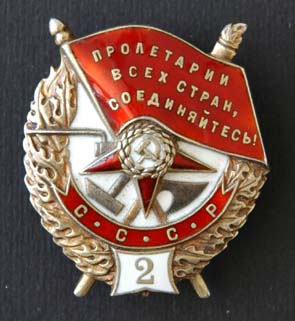


 0
0 -
Hello,
in the past, I've seen cast copies of the Nevskij Order, then silver-plated. They have a rather good appearance BUT, it's just necessary to touch the rim with a thumb's nail, that a sign remains, showing that the piece is made of soft metal (tin alloy). The same is for XX years RKKA medal and other orders, like Suvorov and Kutuzov.
This type of copies appeared on the market (in Italy, through eastern Europe's dealers) in the early '90s.
Best wishes,
Enzo
0 -
Hello,
many thanks for the replies.
The group appeared for sale in South Tyrol. The portrait photo has the mark of a frame-maker from Innsbruck and the seller told me that the group comes from that city, where it was for sale at an antique dealer. In the various passages, something was sold (f.e. the full-size Grand Cross of the Franz Joseph Orden) and other amenities. At last, a good friend of mine told me about the opportunity and I ran to the flea market where this dealer took the group. Before my arrival, other small pieces were away already; and in the pictures you can see what I've been able to take home.
The French medal put for confrontation, is in my collection since the '90s and was for sale at Rauch, Vienna.
The "Literis et Artibus" medal is very rare (well... please, not unique), so I'm quite happy for having added it to my Austrian "Wunderkammer".
To Haynau: that "Feldbesteck" is a nice, gentleman's accessory!
Best wishes,
Enzo
0 -
Hello Glenn,
thank you for your reply: I think that you've solved the "mistery". General Wojnovich received the Ehrenzeichen f?r Kunst und Wissenschaft on April 4th, 1907; on an old Austrian book on the Franz Josef Orden, I've found his picture and it matches with the portait one, acquired with the medals.
Your further observation is also right: it looks strange that with all these decorations a MVK is missing. Actually, when I've bought the group, it was partially "looted" already from other collectors. They bought other "lower" pieces, like another long service cross, buttons, other pictures and who knows what else. The seller was going to separate the whole (remaining) group, but after a short discussion I was able to take these pieces home.
It's a pity when an interesting group is consciously split with the idea: "I'll get much more money". I'm happy with what I've found; I'm not happy with what -for pure ignorance- have been dispersed.
Best wishes,
Enzo
0 -
Hi,
in my preceeding post, I've forgtten to mention that a very similar piece is described and illustrated in "Oesterreichs Orden"; Graz, 1996, page 455 (n? 4.23) and plate 18, as made by Ignaz Joseph Schmidt. The Cross' size is: 32,2 x 27,7 mm. (suspension loop included, mobile suspension ring excluded).
Today, I've had the opportunity to examine and measure my two Knight's Crosses of old type:
1) Cross: 34 x 31 mm.
Crown: 33 x 28 mm.
Ribbon width: 40 mm.
This piece, although unmarked, corresponds in most details to a Schmidt-made cross.
2) Cross: 27,5 x 32
Crown: 26 x 27
Ribbon width: 38 mm.
Both pieces are of the type after 1818; n? 1 has been "updated" (post 1820 award) putting a connecting link soldered to the lower crown's rim (the "doubled" ribbon loop is still present and the "old-fashioned" original triangular ribbon is still present); n? 2 is also an "updated" piece, but with a "barocque" crown and an elaborate "Kriegsdekoration" laurel wreath (a post-1859 addition). If interesting, I'll take some pictures of both pieces soon.
Best wishes,
Enzo
0 -
The same, reverse side:
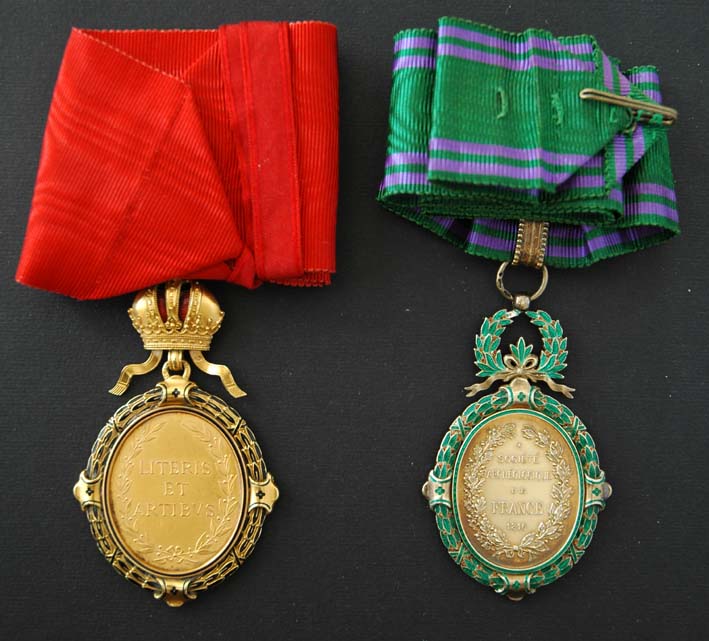
 0
0 -
The Austrian and the French medals:
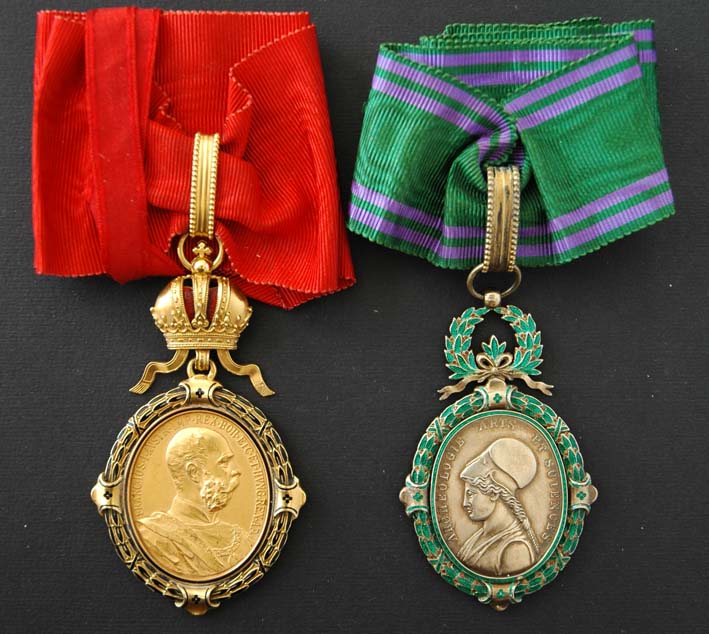
 0
0 -
The group of Orders & Medals:
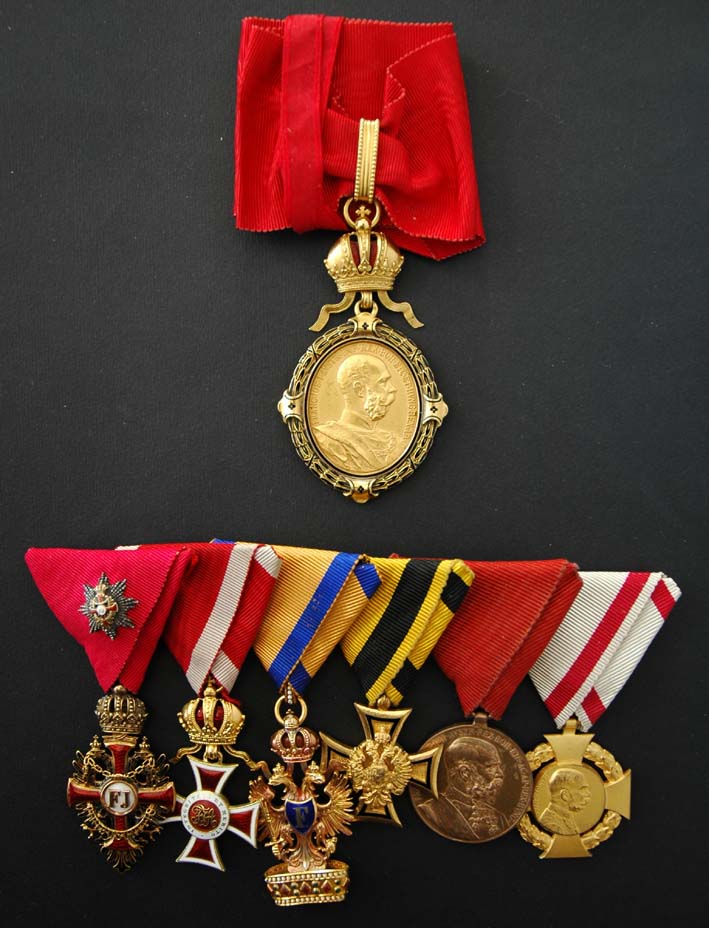
 0
0 -
Hello,
one of my recent acquisitions, is this group of orders, medals and a portrait photograph of an Austrian General wearing, besides his "typical" orders and decorations, the oval, neck medal for arts and sciences, instituted on August 20th 1887.
The decoration is in gold and black enamel; ring, crown and medal's suspension loop are struck with the old Austrian manufacturer's (Rothe) and gold marks.
As a comparison, I add the picture of the medal, along with a French medal of the Archaeological Academy (this piece too, shows old Austrian marks).
Does anyone have an idea on who's this general?
Many thanks in advance, for any help and advise,
Enzo
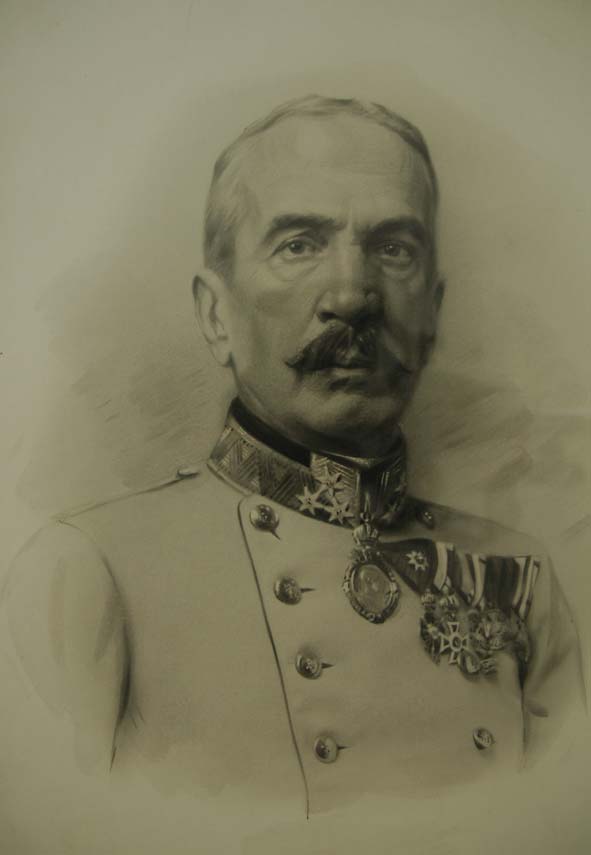
 0
0 -
Hello,
on Tamman's book, I see a "AK" mark for Andrei Antonovich Kovalskij, assayer in Moscow, 1821-1856.
Best wishes,
Enzo
0 -
Hello,
Here's a strange (to me) test-pilot's badge, different from the usually known award: until now I had no success as to know what does the cyrillic acronym "ZPLS" mean. Any idea?
Many thanks in advance,
Enzo
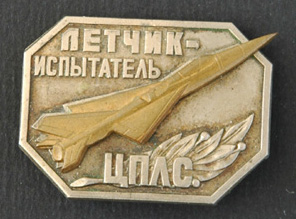
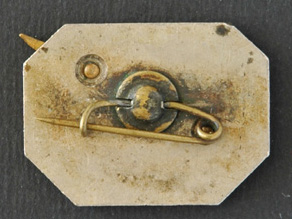

 0
0 -
Hello Slava,
thank you very much for the information!
Enzo
0 -
Hello,
actually, I don't know who was the designer of this badge: the Russian ispiration is quite evident, but I think the prototype came directly from Messrs. Rothe's workshop.
Let's see if any further information would emerge.
Regarding the copy, I've forgotten to give its measures: 61 x 42,8 mm. The piece shown in the picture was bought from me, directly at Rothe's in 1979, and it's silver-plated bronze. Rothe supplied copies in silver too (too expensive for a then young student!), and lately I've seen such copies emerge on the market, struck with fake "old-Austrian" silver and manufacturer's marks.
In this short study, I've described the only copy made by the former manufacturer; there exist also cast copies, moulded from an original piece, but I think that they can't deceive even the beginner.
Best wishes,
Enzo
0 -
Hi Veteran,
I see that both you and me had the privilege to know Prof. Fattovich and see his fine collection. I've studied in Venice, so it was easy to meet him.
He was a real gentleman and, besides the collection, he had a huge library. He was always ready to give help and advise. I can say that if I've finally choosen to specialize my collection on Austria-Hungary, it was thank to him and his enthusiasm.
Yes, the type with separate crown is rare (the one with oak leaves would be much, much more...).
Best wishes,
Enzo
0 -
Hi Christian,
first of all, thank you very much for the information!, Now I'll go and look for Yudin's biography in "Kavalerij Ordena Slavy Trekh Stepeney", Moscow, Voyennizdat, 2000.
Thank you too for the further reference.
I've bought the piece back in 1993 in Milan, at the "Militalia" militaria show for 900.000,- Lire (approx. 450,- Euro).
The piece shows a lot of wear and a point is even slightly bent, but I agree, the patina and overall appearance are highly attractive.
Another question: what type of gold is that of the Slava 1st Class? I mean if 18, 22 or 24 Carats...
Thank you again and best wishes,
Enzo
0 -
The reverse shows the differences even better.
I hope everyone would enjoy, update and correct this short study.
Best wishes,
Enzo

 0
0 -
And now, last but not least, the comparative images of the original piece with the copy of Rothe & Neffe, made after 1918. One of these copies is already illustrated on Michetschlager's "Das Ordensbuch der gewesenen Oesterreichisch-Ungarischen Monarchie" from 1919.
The same type of copy, is illustrated also in Mericka and Prochazka.
What's very visible, is the different angle of the batons' crossing, 90? for the original piece, and more "elongated" for the copy. Note that the copy, although differently "assembled" is made with the original dies.
The original is at left.
Obverse:
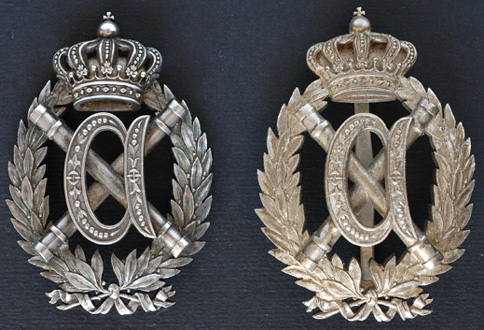
 0
0 -
The marks impressed on the reverse:

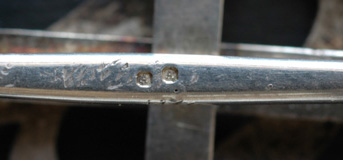

 0
0 -
The reverse:
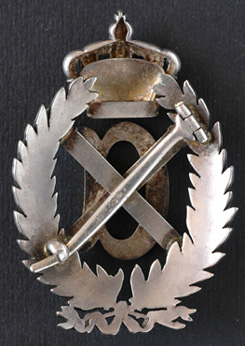
 0
0 -
Hello,
I think it could be useful for us all, a brief description of this very rare piece, then compared to the most encountered copy of it.
This is a rather unique type of decoration -for Austria- because most commemorative signs were in the form of medals and/or crosses.
On May 21st 1899, the Emperor Franz Joseph addressed a handwriting to General Piret de Bihain, expressing the idea to create a commemorative badge "to be worn on the right side of the breast" (...auf der rechten Brustseite zu tragen...).
The very well known Jewellers Rothe prepared the prototypes and the one approved consisted of an oval laurel wreath superimposed with two crossed marshal's batons, and the crowned monogram "A" (for "Albrecht"); the fastening pin is diagonal.
The original badge measures 59 x 41 mm; the material is silver.
At the Austrian State Archive - Kriegsarchiv, it is preserved the transcription of the Emperor's decree and the list of the Officer's of the late Archduke's military entourage, comprising 33 names. The list was lately added with 4 further names.
The german text of the institution's decree (from the copy at the Kriegsarchiv):
Abschrifteines Allerh?chsten Handschreibens vom 21.Mai 1899 an den General der Cavallerie EugenFreiherr Piret de Bihain._____________________Lieber General der Cavallerie Freiherr von Piret.Sie haben an der Spitze jener wenigen noch lebenden Officiere, welche sich des Vorzuges r?hmen d?rfen dem verewigten Feldmarschall Erzherzog Albrecht in pers?nlicher Dienstleistung nahe gewesen zu sein.
Angesichts das Standbildes des Erzherzog-Feldmarschalls, will Ich dieser Auserlesenen anerkennend gedenken, indem Ich denselben ein ?Erinnerungszeichen? verleihe, welches auf der rechten Brustseite zu tragen ist.
Wien, am 21. Mai 1899Franz Josephm./p....and this is the recipient's list (also from the data at the Kriegsarchiv):
VerzeichnisZu N.? 1171 v. 1899M.K.S.M.General der Kavallerie Eugen Freiherr Piret de Bihain
Feldzeugmeister Philipp Graf Gr?nne
Feldzeugmeister Zeno Graf Welsersheimb
General der Cavallerie Andreas Graf P?lffy ab Erd?d
General der Cavallerie Hilbert Freiherr von L?hneisen
Feldmarschall-Lieutnant Victor Graf Dubsky von Trzebomislitz
Feldmarschall-Lieutnant Alois Graf Paar
Feldmarschall-Lieutnant Franz Sch?naich
Feldmarschall-Lieutnant Anton Freiherr von Malowetz
Feldmarschall-Lieutnant Johann Groller von Mildensee
Feldmarschall-Lieutnant Ferdinand Freiherr von Franz
Feldmarschall-Lieutnant Wladimir Freiherr von Spinette
Generalmajor Guido Graf Dubsky von Trzebomislitz
Generalmajor Ludwig Fischer-Colbric
Generalmajor Stephan Szmrecs?nyi de Szmrecs?ny
Generalmajor Wilhelm Graf Palffy-Daun ab Erd?d F?rst von Teano
Oberst Ludwig Graf Breda
Oberst a.D. Ernst Graf Chotek
Oberst Viktor von Koller
Oberst d.R. Lothar Freiherr von Hennet
Oberst Josef Fajta
Oberstlieutnant Theodor Hanke
Oberstlieutnant d.R. Johann Freiherr von Bavier
Major a.D. Emerich Kohl
Major a.D. Franz Graf Lamberg
Major in der Res. Ferdinand Prinz Lobkowitz
Major a.D. Franz Graf Thun-Hohenstein
Major a.D. Johann F?rst Khevenh?ller
Hauptmann Anton Wahl
Rittmeister a.D. Gabriel Graf Festetics
Rittmeister d. Ung. Ldw. Nikolaus F?rst P?lffy ab Erd?d
Oberlieutnant i.d.Res. Johann Prinz zu Schwarzenberg
Stabsarzt Doctor Eduard Ritter von H?bl-Stollenbach
(names added later to the list, with a different calligraphy):
FZM Heinrich Freih. von Beck
Oberlieut. a.D. Max Freiherr von Redwitz
Oberstlieut. d.R. Rudolf M?riany de Markus et Datisfalva
Major der Ung. Ldw. Zoltan Szabo.
Now, the pictures of the original badge:
Obverse:
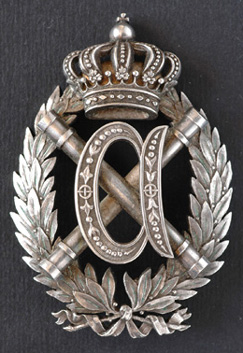
 0
0




Order of the Red Banner, "Mirror Type"
in Russia: Soviet Orders, Medals & Decorations
Posted
Hi all,
this is my Order of the Red Banner, screwback "Mirror Type", corresponding to Durov's Type 1, Variation 2; award number 1213: